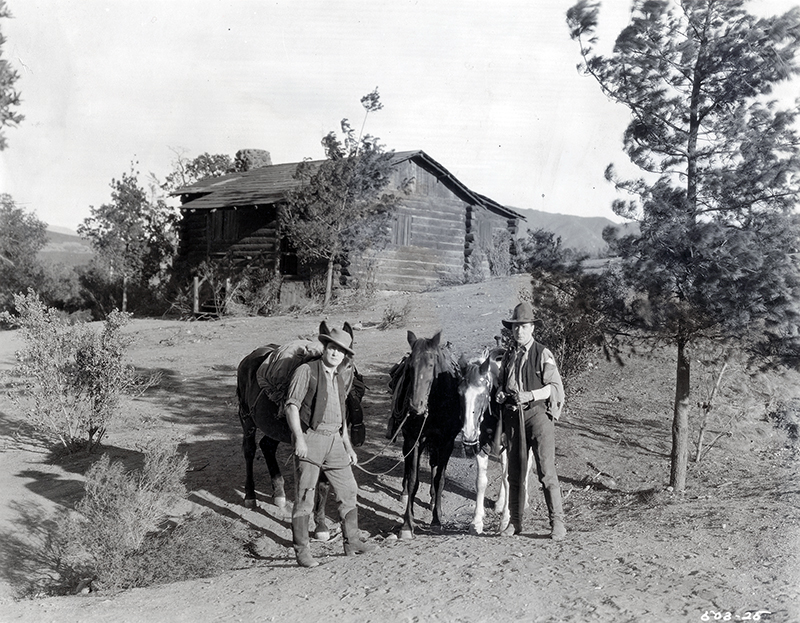|
|


Click image to enlarge
William S. Hart (as the title character) and Gordon Russell (as Buck Holden) in a scene from Hart's penultimate film, "Singer Jim McKee" (Paramount 1924). Caption on back of 8x10 publicity photograph reads:
Singer Jim McKee and Buck Holden watch the pursuit of the posse.
About "Singer Jim McKee." From Koszarski (1980:131): Produced by the William S. Hart Company; presented by Adolph Zukor and Jesse Lasky; distributed by Paramount; New York premiere March 23, 1924; released March 3, 1924; ©February 1, 1924; seven reels (7098 feet, later 6900 feet). Directed by Clifford S. Smith; screenplay by J.G. Hawks from a story by William S. Hart; photographed by Dwight Warren and Arthur Reeves; edited by William Shea. Print sources: LC; MoMA. CAST: William S. Hart (Singer Jim McKee); Phyllis Haver (Mary Holden); Gordon Russell (Buck Holden); Edward Coxen (Hamlin Glass, Jr.); William Dyer (Hamlin Glass, Sr.); Bertholde Sprotte (Dan Gleason); Patsy Ruth Miller (Betty Gleason); George Siegmann ("Brute" Bernstein); Baby Turner (Mary, as a baby). SYNOPSIS: High up in the mountains, "Singer Jim" and his pal Buck are disconsolate because their mine turns out to be worthless. In an old cabin they find the disguise of a notorious bandit, and in desperation to obtain money for his motherless daughter, Buck holds up a stage coach and Jim helps him. The posse trails them. Jim, with the baby, makes a getaway, but Buck is killed by the sheriff. Years later, the girl has grown to womanhood, but at a dance she is shamed by her clothes not being like the others. Jim again figures on taking a chance and robs a stage coach. Giving the money to the girl Mary, she goes to a bank and by the numbers of the bills the money is identified. The banker's son holds her and attempts to attack her. She phones for aid, and with the help of the sheriff Jim arrives in time, but he is caught, accused of the old murder of his pal by the bank president, who was the ex-sheriff, and is sent to prison. After serving his term, Jim, sore on humanity, goes back to the hills. Mary in the meantime learns the truth, and, realizing she loves Jim, goes into the hills and finds him. [Moving Picture World, April 12, 1924] REVIEWS: Hart [is] a far better actor than author — his latest story [is] a sickly sentimental and soft affair that gives [the] star too much mushing and too little action. ... [This] may please his loyal following ... but those who want the fightin' Bill Hart of old won't think much of this kind of business. Singer Jim McKee, while it gives the star unlimited opportunities for heroics and acts of sacrifice, is overburdened with sentiment. Hart plays around with baby booties, caresses his partner after the latter knocks him down, fondles a parrot, a calf and what-not, besides any number of loving scenes. ... His saddle and horse are sadly neglected. Naturally there is a romantic ending with Bill marrying his adopted child, though according to the lapse in time, he must be much more than twice as old as she is. [Wid's, March 30, 1924] A typical Bill Hart vehicle, giving our hero a chance to emote over his Pinto pony, to fight a mob single-handed and to prove to one woman that he is one of Nature's noblemen. This is not unlike the last Hart effort, Wild Bill Hickok, in spots. Reminiscent is the moment when Bill — clad in a white shirt — stands up before a firing crowd and manages to stay in one piece. [Photoplay, June 1924] LW3089: 9600 dpi jpeg from original photograph purchased 2017 by Leon Worden.
|
WATCH FULL MOVIES
Biography
(Mitchell 1955)
Narrated Biopic 1960
Biography (Conlon/ McCallum 1960)
Biography (Child, NHMLA 1987)
Essay: The Good Bad Man (Griffith & Mayer 1957)
Film Bio, Russia 1926
The Disciple 1915/1923
The Captive God 1916 x2
The Aryan 1916 x2
The Primal Lure 1916
The Apostle of Vengeance (Mult.)
Return of Draw Egan 1916 x2
Truthful Tulliver 1917
The Gun Fighter 1917 (mult.)
Wolf Lowry 1917
The Narrow Trail 1917 (mult.)
Wolves of the Rail 1918
Riddle Gawne 1918 (mult.)
"A Bullet for Berlin" 1918 (4th Series)
The Border Wireless 1918 (Mult.)
Branding Broadway 1918 x2
Breed of Men 2-2-1919 Rivoli Premiere
The Poppy Girl's Husband 3-23-1919 Rivoli Premiere
The Money Corral 4-20-1919 Rialto Premiere
Square Deal Sanderson 1919
Wagon Tracks 1919 x3
Sand 1920 Lantern Slide Image
The Toll Gate 1920 (Mult.)
The Cradle of Courage 1920
The Testing Block 1920:
Slides, Lobby Cards, Photos (Mult.)
O'Malley/Mounted 1921 (Mult.)
The Whistle 1921 (Mult.)
White Oak 1921 (Mult.)
Travelin' On 1921/22 (Mult.)
Three Word Brand 1921
Wild Bill Hickok 1923 x2
Singer Jim McKee 1924 (Mult.)
"Tumbleweeds" 1925/1939
Hart Speaks: Fox Newsreel Outtakes 1930
|
The site owner makes no assertions as to ownership of any original copyrights to digitized images. However, these images are intended for Personal or Research use only. Any other kind of use, including but not limited to commercial or scholarly publication in any medium or format, public exhibition, or use online or in a web site, may be subject to additional restrictions including but not limited to the copyrights held by parties other than the site owner. USERS ARE SOLELY RESPONSIBLE for determining the existence of such rights and for obtaining any permissions and/or paying associated fees necessary for the proposed use.









































